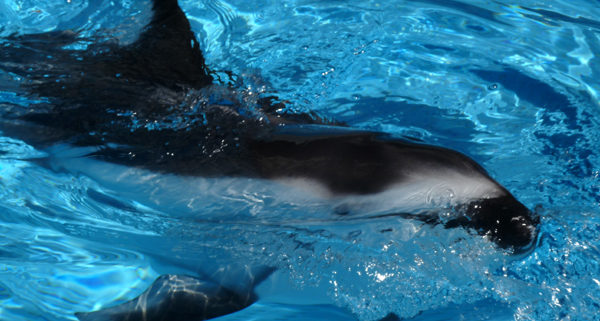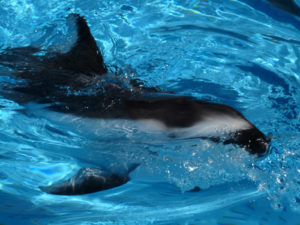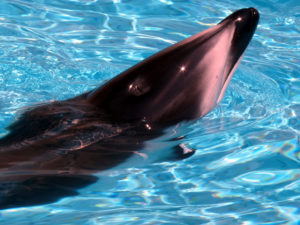Pacific White-sided Dolphin Common name: Pacific White-sided Dolphin. Scientific name: Lagenorhynchus obliquidens Size range: Maximum length of 2.3 meters. Identifying Features: The Pacific White-sided Dolphin’s back is black, the sides are striped light and dark gray, and the belly is white. They have a dorsal fin that located in the middle of the back and is very curved . They are a very gregarious species, often seen in large groups that range from 1 to 1000 (mean: 62, median: 15, mode: 6), and will often leap clear of water. Habitat: Pacific White-sided Dolphins are found continuously throughout the north Pacific. In the eastern part of their range, Pacific White-sided Dolphins are found from 20º N to 61ºN. Through out their range they are found in open-ocean and coastal waters. In Canada, Pacific White-sided Dolphins were primarily considered a pelagic species, however since the mid-1980s their distribution has shifted and they are increasingly common in coastal waters. Prey (food): Pacific White-sided Dolphins eat herring, capelin, Pacific sardines, squid, anchovies, salmon, rockfish, pollock, hake and other small fish. Predators: Transient killer whales and sharks both eat Pacific White-sided Dolphins. When the dolphins first came back to B.C. waters, it took the Killer Whales a couple of years to figure out how to catch the fast-moving dolphins. Some Killer Whale pods drove groups of dolphins into small bays and killed them en masse but this behavior is no longer as common, suggesting the dolphins have learned to avoid this trap. Life Cycle: The maximum age recorded for a female Pacific White-Sided dolphin is 46. The oldest male recorded is 42. Females have their first calf when they are seven to nine years old. Length of pregnancy (gestation period) is around 12 months. When the calves are first born they are approximately one metre long and weigh roughly 15 kg. Females will nurse their calves for eight to ten months and give birth approximately every 4.5 to five years. In B.C. most newborn calves are sighted between June and August but researchers have yet to determine whether there is a defined calving season here. Illustration by Isabella de Souza Diaz
References: Harbo, R.M.(1949) Whelks to whales: Costal marine life of the Pacific Nothwest, Madeira Park: Harbour Publishing CO. Ltd from ” Whelks to whales” Heise, Kathy. 1997. “Life history and population parameters of Pacific white-sided dolphins (Lagenorhynchus obliquidens).” Report of the International Whaling from http://www.vanaqua.org/learn/aquafacts/cetaceans/pacific-white-sided-dolphin Heise, K.A. 1997. Diet and feeding behaviour of Pacific white-sided dolphins (Lagenorhynchus obliquidens) as revealed through the collection of prey fragments and stomach content analyses. Rettrieved (not mentioned). From http://wildwhales.org/pacific-white-sided-dolphin/ Pacific White-Sided Dolphin.- The Dolphins of British Columbia, Canada. Dolphins in BC. Retrieved (not mentioned). From http://www.bcadventure.com/adventure/wilderness/animals/pacdol.htm Pacific White- Sided Dolphin. Dolphin Facts and Information. Retrieved February 23, 2012 from http://www.dolphins-world.com/Pacific_White_Sided_Dolphin.html
Author: Isabella de Souza Dias







Leave a Reply
Want to join the discussion?Feel free to contribute!